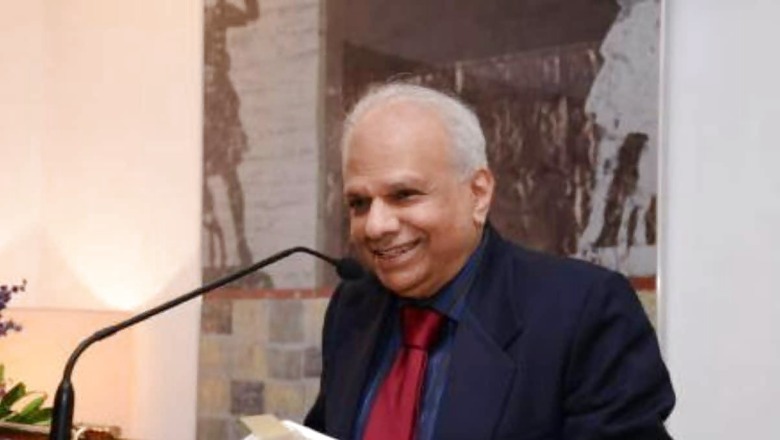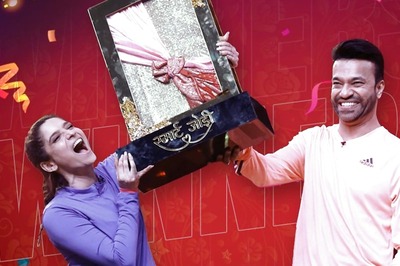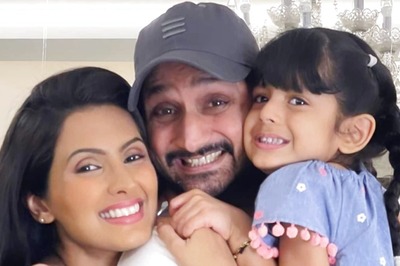
views
Nidhi Dalmia, previously an entrepreneur and scion of industrialist Ramkrishna Dalmia, made his debut as an author with ‘Harp’ in 2016. Recently, he introduced his second book, ‘Afternoon.’ Before venturing into writing, he managed Dalmia Biscuits in Rajpura, Punjab, and later oversaw operations at Edward Keventers in Delhi, where they produced various dairy products. He talks about his new book, Afternoon and what inspired it.
- Your family has a remarkable legacy in India’s industrial landscape. What inspired you to pursue a career in writing despite being part of one of India’s oldest industrial families?
Industry interested me greatly right from the very beginning. I could see the multiplier effect it had in creating jobs, giving purchasing power, whole markets springing up next to the factory. The engineering, the innovation, the knowledge of machines, their hum inspired me.
The Arts, scholarly pursuits were always encouraged in our home alongside growing up with Industry. Home schooling made me well versed in Hindi and Sanskrit from a very young age. I acquired a vast selection of Hindi and Sanskrit books of my own collected from Chowkhamba, Munshi Ram Manohar Lal in Nai Sarak, Gita press, Gorakhpur, Banarasi Dass.
My father wrote a journal every day and later on wrote some books and came out with some booklets like Fearlessness and One World Government. My mother was very scholarly and wrote poems especially during the Freedom struggle. My siblings came out with home magazines with articles by the family. Reading and writing became part of my sense of values. There was free time for creativity. I felt free to choose my career.
- Talking about ‘Afternoon’, the story spans continents and cultures. How did you make the characters relatable and authentic despite their diverse backgrounds?
Characters become authentic through getting into their minds and spirits. On having empathy with their struggles and understanding and identifying with their dreams. One gets into each role and lives it out with sincerity. They become relatable through their follies, dreams, hubris at times – their being utterly human – making mistakes, having courage, persistence, foolishness at times especially when it comes to the other sex and wisdom at other times in the scheme of things.
- The relationships in the book are complex and dynamic. How did you navigate the challenges of portraying love, jealousy, and competition in an authentic and relatable way?
There were a number of serious contenders for Catherine vivacious, attractive, intelligent, appealing -both in New York and in Berkeley. In a free society with its easy mixing of boys and girls where these guys spent time with Catherine in class, in Tennis, in dances, in generally hanging out there was a lot of competition. This was compounded by the sexual revolution ethos of the times. She enjoyed their company. There was also the inevitable friction with Rajiv because they lived together. There was the danger that something might happen. As in Life, the reader also doesn’t know the outcome. This too contributes to authenticity. Intercontinental relationships or love at long distance is all the more difficult because one is in a relationship where the other one is far away. One is young and wants to live Life now but the loved one is not there. The relationship is bult on faith and hope. Time whittles away at it. This is what happens to people so this contributes to suspense in the plot and thence makes it that much more relatable.
- How did you approach crafting the personalities of the three central characters? What were your inspirations for each of them?
Characters are created from the imagination- what one imagines people to be, what one would like them to be. This comes from within.
Characters are often not created from nowhere. They are an amalgam, a mixture of the many characters one encounters in life, some of them colourful, some of them with their own quirks, insecurities, anxieties, strengths, their life scripts, some of which may have been scripted in childhood
One always draws on one’s experiences, the shared experiences of others. The rest is imagination. The characters acquire more and more life as one writes. Their personalities acquire nuances and layers, partly from life events and their response to them. Some human emotions and feelings have universality, others acquire individual corollaries. The roads we choose to take have profound consequences, shaping in turn our character. The story teller draws inferences. Characters are also formed by factors beyond one’s control, like the Partition of the Indian Sub-continent. The writer has to understand and portray the impact of that on different people.
Empathy, living their lives, imagining oneself in it, really experiencing what they are going through helps create this. As does the maxim of show don’t tell their character traits. The narrator has to become more than a sutradhaar -an actor in the real-life drama being portrayed. One has to become a part of it. “. All the world’s a stage…”, as the Bard said. Total immersion is key as is sincerity.
- How do you approach creating and developing your characters? Are they inspired by real people or entirely from your imagination?
The stories come partly from many interesting people one encounters in life’s journey. Their personalities and traits get mixed up, as do their stories. Many things are invented, imagined both in the narrative and in the personae of the characters, as it should be in fiction. The inspirations for each one of them came from an amalgam of many different people that I had the good fortune to come across.
Some of them acquire such rich personalities that one would like to come across them, meet them, have them as friends, some of the main protagonists one can fall in love with, have them in one’s life.
We all have stories to tell. A desire to tell tales came from the love and longing I had experienced as well as the universality of these deep feelings, the intensity of the pain and ache, the bliss and completeness of it, the sense of fulfilment. The circumstances that pull people asunder, the effort to reconcile conflicting goals inter-se as well as within one self.
Inspiration also came from certain characters whom I had the pleasure to encounter, whose personalities and traits got mixed up, as did their stories. Many things were invented, imagined both in the narrative and in the personae of the characters, as it should be in fiction.
- What techniques do you use to make your characters feel authentic and relatable to readers?
Part of the story is there within me. It starts like that. But it’s not complete. The rest of it develops on its own as I write. I don’t know the rest of it or how it’s going to end. It unfolds. Sometimes I get stuck. But as I persist. Inspiration strikes or an idea comes. Sometimes the narrative or the description doesn’t work. Then I change it. Ideas also come from just living and observing.
Events, other people create challenges. Uncertainty comes in. This tension makes the reader want to know more. Every writer has a different formula. In my case I don’t have a paradigm or set techniques. The characters acquire their own life as the story unfolds and takes shape. Their personalities develop organically and that helps to make it true to life. They evolve and become more and more relatable, warts and all.
- What challenges did you face while blending historical facts with fictional storytelling? And on the flip side, what were the most rewarding aspects of this genre?
Research had to be detailed and painstaking. Historical facts had to be checked and rechecked from many different sources, sometimes to the point of boredom. Old maps had to be pored over, details extracted from a variety of materials including archival. The fiction had to be created but the backdrop of history had to be irreproachable
The rewarding part was the interplay between the characters, their emotions, their responses, their expectations, the games people play, the ends they have in minds, their flirtations, the outcomes to their tentative approaches.
- Can you share the journey of transitioning from a background deeply rooted in industry to embracing the art of writing? Were there specific experiences that triggered this shift?
There was no transition. It was a different matter that when I ran factories, I couldn’t find the time. They were all 24 hours, 3 shifts. I would go at 3 am in the morning to the shop floor. I wanted to write in addition to running a business, not in place of it. I was always praised in School for my essays. Later on, when I wrote letters to the Government on various matters, bureaucrats praised my writing saying ‘you have thought through every word’. When I wrote briefs for Lawyers for my legal matters, they found it very well drafted. Then when I attempted writing fiction later on in life, I found that it read well. I always wanted to write.
When one of my closest school friends asked me what I planned to be when I grew up. He prefaced his question by saying it is clear what you will do when you grow up, but what will I do? I came from a family of Industrialists. He took it for granted that that is what I would do. I said a writer. He had heavy shoulders. I said a boxer. You have the physique and you are very good, I said. But he didn’t think so. I too was wrong he turned out to be a successful restauranteur in Melbourne, Australia. “Catch your dreams before they slip away’ sing The Stones. I also wanted to describe the hope and idealism of the 60 s that I and many others thought would never end, the coming of age and growing up in the late 60’s. How the themes conveyed were universal and how everyday life was interspersed with the music of the times. I wanted to write about the universality of human emotions and feelings and even more so of human experience: about the brotherhood of all men and attempts at categorization a distortion of the continuum. To tell a tale about how one is torn between love and obligation, between the head and the heart, between one’s social contract and what one really wants. The individual choices one has to make with profound consequences. To portray a deeply felt love story, as different as any individual experience can be.
- Could you provide insights into your writing process? Do you follow a specific routine or approach while working on your books?
I prefer to write in the first half of the day when I’m at my freshest. A lot of imagination, creativity and inspiration is required besides perspiration. I prefer to invite on a desktop and do so in our drawing room called the NeelaKamra because of its blue chandelier. It overlooks the back garden. When I travel, I have to use the laptop. To stay inspired, one has to at times imagine oneself in it, as an actor in the real-life drama being portrayed on stage. One has to become part of it and live it. To stay motivated, one has to believe in oneself and in the story. One has to get immersed in it. Each word has to be well thought out. One cannot waffle or pad. Quantity is not important, quality is. Therefore, sincerity counts. Show don’t tell. This is universal advice given to writers. It really works. One has to keep such things in mind. One has to not worry about the critics. One can’t please everyone. Enough readers have to like it. There has to be a discipline to sit without disturbance and write for a certain amount of time or a certain number of words every day, even if some days it doesn’t go as good. Everyday won’t be the same. The place of writing should preferably be different from the place of other work.




















Comments
0 comment